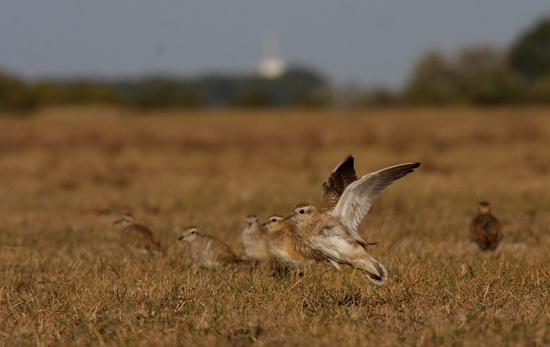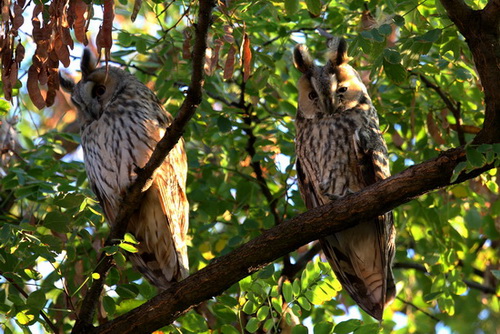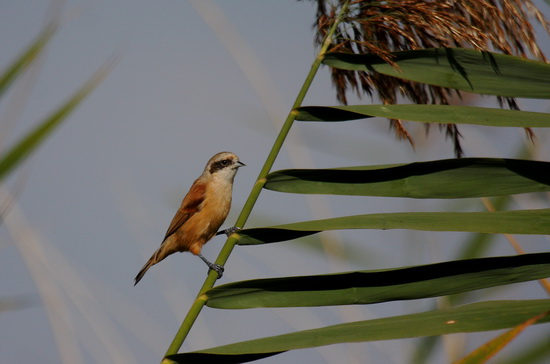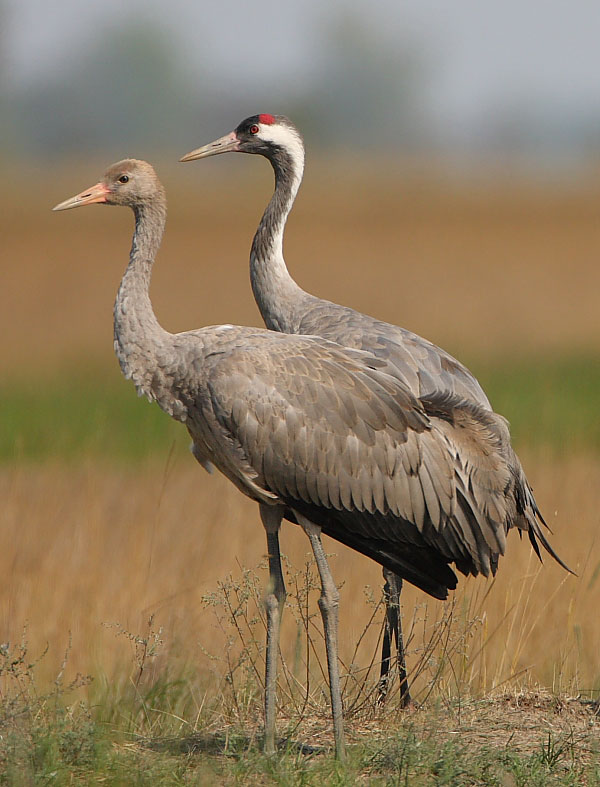Crane Spectacular & Wild Goose Chase tour for Ornitholidays
Our friends from Ornitholidays (http://www.ornitholidays.co.uk/) arrived on the 31st of October with Mike Witherick as leader.
They arrived at the very best time for some geese watching as unprecedented number of Red-breatsed Geese arrived to the Hortobágy Plains this autumn! Flocks of 30-80 have been seen and the total number of redbreasts estimated to be over 300 in the region! So it was not surprising that already on the arrival day on the way from the airport to the Hortobágy the group had 11 Red-breasted Geese in the fading afternoon light. The leader from Sakertour side was Gábor Simay and he shall give details of this tour soon!

Crane portrait Photo: János Oláh
Sakertour team
Limosa 2009 Crane tour
The annual Crane week (17-24 October) for Limosa Holidays was once again a great event with many birds seen. Check out their full itinerary here: http://www.limosaholidays.co.uk/. The tour started in the Zemplén Hills with Ural Owl, White-backed Woodpecker, a fine Alpine Accentor and Rock Bunting. All the usual goodies were seen on the Hortobágy (Lesser White-fronted Goose, Great Bustard, Saker etc.) plus some unexpected bonus like a Dalmatian Pelican.
The tour also coincided with the zenith of the cranes which was 101,500 (a new record for Hortobágy!) this autumn so surely there were enough birds around to see….
Sakertour team
Beat Rüegger´s group from Switzerland
We started our trip in the Zemplén hills, where we managed to see a superb Ural Owl and several species of woodpeckers. On the way to the hills we saw 2 Imperial Eagles together with 2 Saker Falcons. During the rest of our trip we found 6 individuals of the latter species.
On the Hortobágy, besides our target species, like the Great Bustard (9), Stone Curlew (9), Dotterel (100+), Lesser White-fronted Geese (7) we saw a Black-winged Pratincole at the same site where we saw 14 White-tailed together with 2 Impeial Eagles and 9 Jack Snipes. Other highlights were a very late Marsh Sandpiper, Ferruginous Ducks, Bar-tailed Godwit and many,many Red-throated Pipits.

Part of a flock of Dotterels Photo: Simay Gábor

Long-eared Owls at a poost site Photo: Simay Gábor

Penduline Tit Photo: Simay Gábor

Cranes flying to a roost site Photo: Simay Gábor
The Pluvialis sp. at Nagy-Vókonya debate
In the last few days there is a wide discussion of the ID of the Pluvilis seen at Nagy-Vókonya on the Hortobágy. Finally all experts and comments have concluded to be a Pacific Golden Plover (Pluvialis fulva).
Another image of this bird below.

Pacific Golden Plover Photo: János Oláh
Rare bird seen on a Sakertour trip!
Today we were lucky enough to find the second (if accepted) record of Pacific Golden Plover for Hungary. This adult bird was seen at Nagy-Vókonya wetland in the Hortobágy. Other highlights of this magnificent day were 22 Lesser White-fronted Goose, 8 White-tailed Eagle, 4 Imperial Eagles, Bar-tailed Godwit, many Red-throated Pipits and a wonderful roost-flight of Cranes (20 000).
Yesterday´s Crane count on the Hortobágy was 48,000 individuals at 4 main roosting areas.

Pacific Golden Plover Photo: János Tar
Sakertour team
Richard Smith´s party
A group of friends just arrived for a three day birding in Hortobágy and an additional day in Zemplén Hills.
On our first day we had an action-packed start. We were concentrating on raptors and we managed to see 3 White-tailed Eagles, 5 Imperial Eagles, a Long-legged Buzzard, Hen Harriers, Goshawk and 2 Sakers.
Other goodies included Ferruginous Ducks, 14 Great Bustards, 7 Stone-curlews and 84 Dotterels.

Winter plumaged Dotterel Photo: János Oláh
Sakertour team
Crane Photo-season started!
Late September and October in the Hortobágy National Park is an action-packed period as the autumn bird migration is in full swing. One of the specialities is the masses of cranes visiting the park. The cranes arrive from mid September onwards and the numbers gradually build up day by day to an impressive 100,000 by the second half of October.
The Crane photography is always special and not many photographers appreciate that the Hortobágy (by far the biggest of the European Crane gathering places) can be as good for crane photography as the well-known Hornboga in Sweden! In fact the variety of subjects is probably wider and ranges from bathing and drinking Cranes to feeding and roosting Cranes.
Sakertour is slowly getting to grips with these subjects and following our first year in 2008 we now have many hides for the various subjects. We use mobile hides for the ever changing drinking and bathing places but we also have permanent hides for flying, feeding and roosting Cranes.

Adult and juvenile Cranes Photo: János Oláh
The roosting hides are located in a fishpond where the Cranes go to roost every evening. As it is not possible to leave the roost area after dark as sometimes there are Cranes sleeping as close as 15 meters to the hides, we built a sleeping cabin with a capacity for 4 photographers. This way after the photo session they can move to the cabin (heated and comfortable) and then go back to the hides pre-dawn without disturbing the birds. A truly magical experience!

Adult Crane preparing to bath Photo: János Oláh
Please follow the autumn photographer results in our galleries or here on the blog!
More images from the beginning of the Crane Photo-season you can find here:
http://hortobagymadarfoto.wordpress.com/
or in our galleries:
http://www.sakertour.com/hidegallery.php?hide=15
http://www.sakertour.com/hidegallery.php?hide=16&author=&text=
Sakertour team
The first images from a new hide!
We have finished the installation of another superb hide in the Hortobágy National Park. It is a very comfortable multi-functional hide for several target birds. This is in steppe habitat and hopefully will be very active from April to October in future. It is a ´steppe drinking´ hide which will surely increase the photographable species list in the Spring tours! Also can be very productive in the Crane migration time or even for geese.
The first pictures were taken from this hide just recently and our firts guests were there today!

Greyleg Goose Photo: János Oláh

Juvenile Ruff Photo: János Oláh
We will updating our ´hide´ section on the website this winter with more pictures of the hides and also a more accurate species list with when to photograph comments.
We looking forward a very busy autumn with many many visiting birders and photographers but we will continously keep everybody updated about our activity!
Sakertour team
Lance Degnan´s group
We had a group of friends visiting the Hortobágy National Park led by Lance Degnan and they had two days with Sakertour guides on the 3rd and 4th of September.
They were after not only the special birds of the park but also but some relaxed birding too.
The two days birding yielded a lot of good birds and some great numbers too!
Best sightings:30 Pygmy Cormorants, 3 Black Storks, many Garganeys, Ferruginous Ducks, up to 10 White-tailed Eagles, 7 Short-toed Egales, Montagu´s Harriers, a male Pallid Harrier, Long-legged Buzzard, 20 Red-footed Falcons, Hobby, 3 Sakers, 2 Little Crakes, 1500 Common Cranes, 11 Great Bustard, 6 Stone-curlews, 37 Dotterels, Curlew Sandpipers, 30 Long-eared Owls, 3 Hoopoes, many Bee-eaters, 5 Rollers, 20+ Tawny Pipits, 3 Lesser Grey Shrikes and 5 Golden Orioles.
A fantastic experience indeed!

Long-eared Owls Photo: János Oláh
Sakertour team
Woodpeckers at our Drinking Hide
In the last few days due to the extreme draught and also because the migration is in full swing our Passerine Drinking Hide has hundreds of birds daily. Most interesting however that four species of woodpeckers regularly visiting the pool and even the shy Black and Green Woodpeckers are daily guests!

Black Woodpecker Photo: János Oláh

Sparrowhawk Photo: János Oláh
More images of this hide can be seen here: http://www.sakertour.com/hidegallery.php?hide=24
We are preparing our mobile hides for the Crane migration and also two new permanent hides will be available for Crane photography this autumn. At the moment the first family parties of Cranes arriving and now up to 800 birds can be seen in the northern Hortobágy.
Sakertour team

